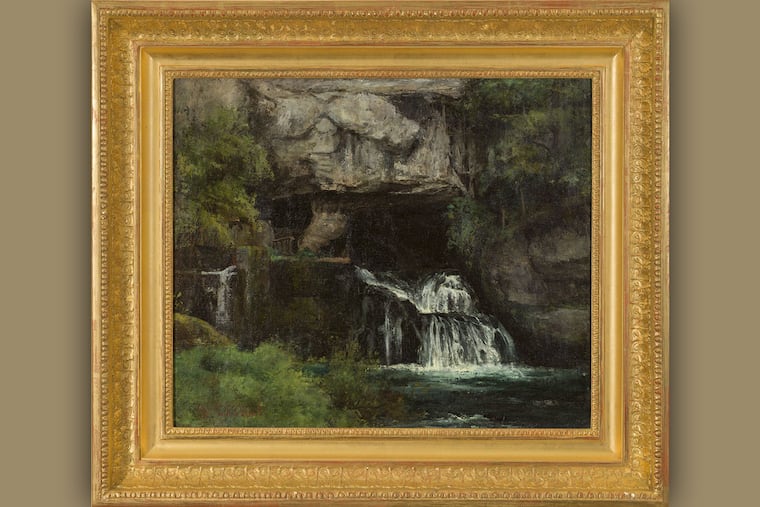The Paris-to-Philadelphia story of a rebel artist, a visionary dentist, and a treasure lost and found
A long-lost 19th century work of art is rescued from a basement and reborn. And now displayed at Penn.

Sometime in the spring of 2016, some workmen doing construction at Penn’s School of Dental Medicine brought some old boxes to the office of vice dean Liz Ketterlinus.
“Lady, we found these in the basement. Do you want them, or should we throw them out?”
The vice dean kept them and asked Lynn Marsden-Atlass, curator of Penn’s art collection to come by to take a look. Sure enough, they found a painting — its varnish so darkened, the image wasn’t even decipherable. But the curator had spent years in Paris, teaching in museums. She looked at the lower left corner of the painting. Three letters were legible:
G. Co
“When I saw that, I said, ‘Oh, I think I know that signature,’” Marsden-Atlass recalled.
After six years of restoration, scientific study, and authentication, that long-lost oil painting is the centerpiece of a current exhibit at Penn’s Arthur Ross Gallery.
La Source du Lison or The Source of the Lison, dating to about 1864, is by renowned French artist and revolutionary Gustave Courbet, leader of the 19th century Realism movement.
The discovery of this landscape is a momentous event for art aficionados, Courbet scholars, and Penn.
“It’s an extremely valuable painting,” said Marsden-Atlass.
We don’t know exactly how it came to be forgotten in the basement of Penn’s dental school.What is known is that its history is intertwined with that of a 19th century Philadelphia dentist and art lover who became the darling of European heads of state.
Thomas W. Evans — the dental school’s Evans building is named after him — was a young Philly dentist, who left West Philadelphia for Paris in the 1840s. After a few years in practice, he was summoned by Napoleon III, who had a terrible toothache. Evans lent his services, and he and Napoleon III hit it off so well that Evans became the court dentist.
He was also a pioneer for his time, using such innovations as nitrous oxide (a.k.a laughing gas) and gold fillings. Soon enough, his services — far less painful than many of his fellow practitioners — were much sought after by other European heads of state. His luxurious home, Bella Rosa, contained artworks he had been given in thanks for his services or had collected. The gallant Philadelphian has even been credited with probably saving the life of Empress Eugenie by helping her escape France when her husband was overthrown. Evans’ carriage that helped her escape is now on display at the dental school.
When Evans died in Paris in 1897, he left an estate of several million dollars and no children to inherit it, said Marsden-Atlass. It became the Thomas W. Evans Society. The Thomas W. Evans Museum and Dental Institute was established on the site of his family’s former homestead at the corner of 40th and Spruce streets, in 1915.
The museum was closed in 1967 for much needed clinic space, and the artworks were put in storage. Penn art officials aren’t certain if The Source of the Lison was ever displayed in the museum.
The only known record of the painting, Marsden-Atlass said, was found in an inventory of Evans’ Paris home after his death, which became part of Penn’s Evans collection.
It wasn’t until May 2022, after the artwork was examined for authentication by the Comite Courbet of the Institut Gustave Courbet in Ornans, France, did Penn get the good news their wayward painting was indeed the real thing.
Fittingly, Courbet was something of an enfant terrible — a rebel in both his politics and art; a champion of the working class and a supporter of the French Revolution of 1848. He challenged romanticism and painted works like The Stone Breakers, depicting workers on a larger scale usually reserved for historic or religious figures.
He turned to painting landscapes as society became more industrialized.
In The Source of the Lison, there are no open vistas, or horizons with clouds and sky, notes Andre Dombrowski, Penn Frances Shapiro-Weitzenhoffer associate professor of 19th-century European art.
“Courbet refuses that,” Dombromski said. “He really sticks you into the nearness of the site. You’re drawn into a very dense and small scale world, and I think there’s a politics to that.” As viewers are pulled in closer than in most landscapes, they’re made more aware of their place in the world and their influence and impact on it. “It seems a very political, proto-environmentalist attitude toward the landscape depiction.”
Several years after Courbet painted The Source of the Lison, he became one of the leaders of a short-lived, socialist rebellion called the Paris Commune. When they lost power, Courbet was blamed for the tearing down of a Napoleonic monument, the Vendome Column. After a stint in prison, he fled to Switzerland and spent the rest of his life in exile.
During that time, he established a studio with other artists. Influenced by Courbet, some of them even imitated his style, making the job of authenticating his painting even more challenging.
But not impossible.
“At the Source: A Courbet Landscape Rediscovered” will be at Penn’s Arthur Ross Gallery through May 28. Seven canvases are on display including the newly recovered painting. Another Courbet depiction of the same site is on loan from a private owner, along withtwo other Courbets.Another two are on loan from the Philadelphia Museum of Art. One is from the Yale University Art Gallery.
The Source of the Lison’s exact place of display at close of the exhibition has yet to be determined, but Marsden-Atlass said it will remain on view on the Penn campus.
Evans’ painting is finally safe at home.
“At the Source: A Courbet Landscape Rediscovered” is on display at Arthur Ross Gallery at the University of Pennsylvania, 220 South 34th Street, Phila. https://arthurrossgallery.org/events/event/at-the-source-a-courbet-landscape-rediscovered/